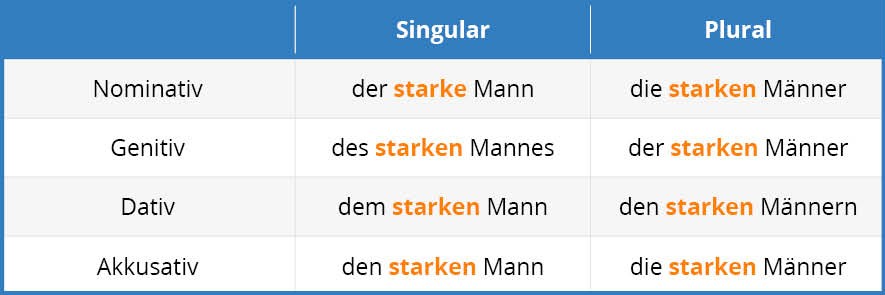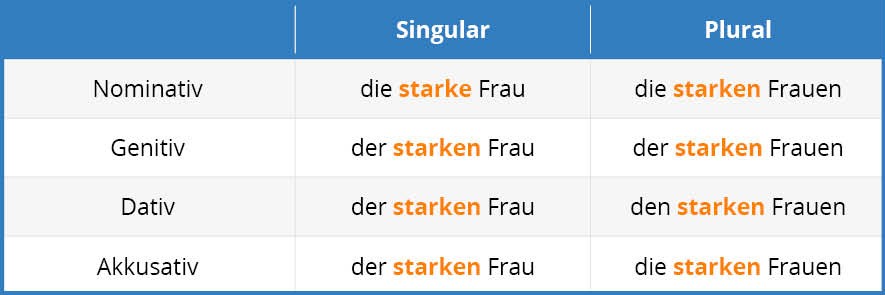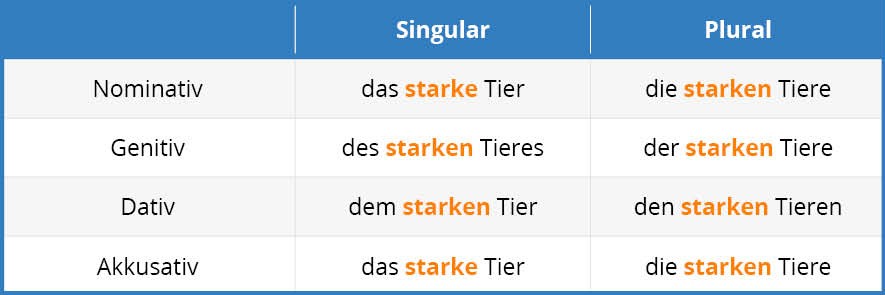German Adjectives
Adjektive im Deutschen – Erklärungen und Beispiele
German Adjectives – Summary
Zusammenfassung
The adjective always comes with a noun, describing it. It can be attributive and predicative. Whereas the attributive adjectives always describe a noun, predicative adjectives always describe a verb. You also call them adverbs. Adjectives have to adept to the case and number of the noun, and also to its article.
- “Der schnelle Hund” – “Die schöne Katze” – “Das große Pferd”
- “Die schnellen Hunde” – “Die schönen Katzen” – “Die großen Pferde”
- “Ein schneller Hund” – “Eine schöne Katze” – “Ein großes Pferd”
Example for some adverbs (schnell – schön – groß):
- “Der Hund ist schnell.” – “Die Katze ist schön.” – “Das Pferd ist groß.”
- “Die Hunde sind schnell.” – “Die Katzen sind schön.” – “Die Pferde sind groß.”
- “Ein Hund ist schnell.” – “Eine Katze ist schön.” – “Ein Pferd ist groß.”
Adjectives with definite and indefinite articles
Definite articles:
- Rule: In the singular forms, adjectives have the ending “-e” and “-en”. In the plural, every adjective has the ending “-en”.
Indefinite articles:
- Rule: In the singular, adjective of nouns with indefinite article can have different endings. In the plural, there is no indefinite article.
German adjectives are a fundamental part of the German language. As an English-speaker you might think that adjectives are not such a big deal. But you have to be conscious about what language you actually want to learn: German! And yes, nearly everything is complicated here, with lots of rules and of course… exceptions!
Luckily, you have chosen language-easy.org! We will try to explain the easy and also difficult parts of German adjectives and make it an easier experience as you might think. So, let’s start right ahead!
German adjectives, as well as in English, describe nouns. But, in comparison with the English language, German adjectives adapt their endings to gender and number of the noun they describe. They also change their endings depending on the case, or whether the German noun they describe has a definite or indefinite article.
Let’s go into some details. When talking about German adjectives, they adapt to a mascline, feminine and neutral gender.
They also adapt to the different German cases: Nominative, genitive, dative and accusative.
Definite German articles are “der, die, das”, whereas indefinite articles are “ein, eine”.
Well, as we have now cleared up some first basic, let us now talk about the different variations of German adjectives. And also about some examples of the most common German articles.
When a German adjective takes an ending that depends on the gender and case of the noun phrase, it is called: Inflection.
German Adjectives varied by Gender and Others
Vom Geschlecht und Anderen beeinflusste Adjektive
Of course all of you German nouns have different genders. And it wouldn’t be German that we learn, if that didn’t influence the German adjective which describes the noun. Well, in German there are three genders:
- A masculine gender
- A feminine gender
- A neuter gender
We also have two kinds of German articles, as we also have in English: A definite article and an indefinite article. We have “ein” and “eine”, which can basically be translated by “a” and “an”. So, let’s see how the gender of a noun influences the endings of German adjectives. Here you can see the examples with definite articles with the adjective “stark” (strong), “Mann” (man), “Frau” (woman) and “Tier” (animal).

In comparison to definite articles, indefinite articles change the ending of the German adjective in a completely other way.
– Whereas plural forms of indefinite articles do not exist here.

Also, very important when talking about German adjectives and their changing endings is the position of the adjective in the sentence. Until now, we have only seen adjectives that are positioned in front of a noun, so they are called attributive adjectives.
If a German adjective has its position after the noun of the sentence, it is called predicative adjective. Here is an example in order to illustrate the different variation of changes:
- Der starke Mann. – The strong man.
- Der Mann ist stark. – The man is strong.
Even though the gender and number of “Mann” are the same, its position in the phrase changed its ending.
German Adjectives and Inflection
Die Flexion
Well, as you have already learned, German adjectives change their ending depending on various factors. If the article of the noun does not tell you, what gender, number or case it is: It’s the adjective’s job to do so. Unfortunately, that’s one of the rather complicated parts of German grammar. However, there are some rules for inflection that will help you to understand its principles.
- Strong inflection
First, If there is no article at all, you have to apply strong inflection. Furthermore, it is used when a noun is preceded by a word or phrase like “ein bisschen“, “etwas“ or “viel“ (a little, some, much). - Mixed inflection
Second, you have to use the mixed inflection when the adjective is preceded by an indefinite article (“ein-“, “kein-“) or a possessive determiner. We have already seen that when talking about indirect articles in the topic above. - Weak inflection
Third and last, you have to use the weak inflection when there is a definite word in place (“der”, “die”, “das”, “des”, “den”, “dem”, “jed-“,” jen-“, “manch-“, “dies-“, “solch-” and “welch-“).
German Adjectives varied by Cases
Adjektive beeinflusst von Fällen
Grammatical cases can also be an important factor that can vary the ending of German adjectives. Of course, gender, number and the kind of articles have their influence, too. So, here everything just comes together! But don’t worry – in the following table you will see that there is a certain structure behind this variation of German adjective’s endings.
Here you have the masculine forms:

Here are the feminine ones:

And finally, here are the neuter forms:

German Adjective Endings and the Superlative
Adjektivendungen und der Superlativ im Deutschen
So, there are also two grammatical forms of German adjectives that should be mentioned: The German comparative and superlative, but also the specific adjective endings you have to apply. Well, let’s have a short look at each of these elements. Please, note that there are specific articles about each one of these elements that go into more detail. Just click on the button under each topic to get redirected.
The German Comparative and Superlative
In case you want to compare two things, people, thoughts, actions, qualities or what so ever, you need a German comparative. German Superlatives are used when you want to make a claim that something, relative to all others, has the most or least of a given characteristic.
- Comparison of equal attributes
“Ich bin so schön wie er” – I am as pretty as he is. - Positive adjective
“Ich bin schön.” – I am pretty. - German Comparative
“Ich bin schöner” – “I am prettier” - German Superlative
“Ich bin am schönsten” – I am the prettiest”
German Adjective Endings
In the context of German adjective endings, it is important to know that there are different endings for nouns with definite and indefinite articles, but also for nouns without an article. So, as already mentioned, you can enter this article for more detail.
Some Last Words…
Einige letzte Worte…
Last but not least I hope that you learned some new things about German adjectives and their variation of word endings. German can be hard sometimes, but, as you have seen in this article, it seems to be far more complicated as it actually is.
Hopefully German still fascinates as at the beginning of your studies – language-easy.org will always be happy to provide you with good information about German grammar topics!
By the way, did you know that you can always stay informed about Germany? About German news and culture? Well, on the website the Deutsche Welle you can find all this information. Use the German skills you have learned already to stay in practice and enter more deeply in the world of German.
In the following you will see some phrases that you should complete with the correct terms. Once you have filled all the gaps, just click on the “correct” button and you can see your errors and the correct results. Good luck and… auf Wiedersehen!



